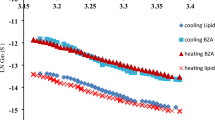Abstract
Tethered bilayer lipid membranes (tBLMs) anchored to a solid substrate can be prepared and individual triangular voltage ramps from zero to 500 mV with a period of 2–10 ms applied to give membrane voltage dependencies with and without the addition of drugs and analytes in order to measure their electro-insertion properties.
Access this chapter
Tax calculation will be finalised at checkout
Purchases are for personal use only
Similar content being viewed by others
References
Cranfield C, Carne S, Martinac B, Cornell B (2015) The assembly and use of tethered bilayer lipid membranes (tBLMs). In: Methods in membrane lipids. Springer, New York, pp 45–53
Cornell BA, Braach-Maksvytis V, King L, Osman P, Raguse B, Wieczorek L, Pace R (1997) A biosensor that uses ion-channel switches. Nature 387(6633):580–583
Vasilkoski Z (2006) The effect of electric fields on lipid membranes. arXiv preprint physics/0701013
Winterhalter M (2014) Lipid membranes in external electric fields: kinetics of large pore formation causing rupture. Adv Colloid Interf Sci 208:121–128
Heimburg T (2012) The capacitance and electromechanical coupling of lipid membranes close to transitions: the effect of electrostriction. Biophys J 103(5):918–929
Alobeedallah H, Cornell B, Coster H (2020) The effect of cholesterol on the voltage–current characteristics of tethered lipid membranes. J Membr Biol 253(4):319–330
Oliver LD, Coster HG (2003) Electrical breakdown of human erythrocytes: a technique for the study of electro-haemolysis. Bioelectrochemistry 61(1–2):9–19
Cranfield CG, Cornell BA, Grage SL, Duckworth P, Carne S, Ulrich AS, Martinac B (2014) Transient potential gradients and impedance measures of tethered bilayer lipid membranes: pore-forming peptide insertion and the effect of electroporation. Biophys J 106(1):182–189
Su Z, Shodiev M, Leitch JJ, Abbasi F, Lipkowski J (2018) Role of transmembrane potential and defects on the permeabilization of lipid bilayers by alamethicin, an ion-channel-forming peptide. Langmuir 34(21):6249–6260
Raffy S, Teissié J (1999) Control of lipid membrane stability by cholesterol content. Biophys J 76(4):2072–2080. https://doi.org/10.1016/S0006-3495(99)77363-7
Tung L, Troiano GC, Sharma V, Raphael RM, Stebe KJ (1999) Changes in electroporation thresholds of lipid membranes by surfactants and peptides. Ann N Y Acad Sci 888(1):249–265. https://doi.org/10.1111/j.1749-6632.1999.tb07960.x
Rols MP, Teissié J (1990) Electropermeabilization of mammalian cells. Quantitative analysis of the phenomenon. Biophys J 58(5):1089–1098. https://doi.org/10.1016/S0006-3495(90)82451-6
Wolf H, Rols MP, Boldt E, Neumann E, Teissié J (1994) Control by pulse parameters of electric field-mediated gene transfer in mammalian cells. Biophys J 66(2, part 1):524–531. https://doi.org/10.1016/S0006-3495(94)80805-7
Lebar AM, Kopitar NA, Ihan A, Serŝa G, Miklavĉiĉ D (1998) Significance of treatment energy in cell electropermeabilization. Electro Magnetobiol 17(2):255–262. https://doi.org/10.3109/15368379809022570
Hoiles W, Krishnamurthy V, Cranfield Charles G, Cornell B (2014) An engineered membrane to measure electroporation: effect of tethers and bioelectronic interface. Biophys J 107(6):1339–1351. https://doi.org/10.1016/j.bpj.2014.07.056
Author information
Authors and Affiliations
Corresponding author
Editor information
Editors and Affiliations
Rights and permissions
Copyright information
© 2022 The Author(s), under exclusive license to Springer Science+Business Media, LLC, part of Springer Nature
About this protocol
Cite this protocol
Alobeedallah, H., Cornell, B.A., Coster, H. (2022). Measuring Voltage–Current Characteristics of Tethered Bilayer Lipid Membranes to Determine the Electro-Insertion Properties of Analytes. In: Cranfield, C.G. (eds) Membrane Lipids. Methods in Molecular Biology, vol 2402. Humana, New York, NY. https://doi.org/10.1007/978-1-0716-1843-1_5
Download citation
DOI: https://doi.org/10.1007/978-1-0716-1843-1_5
Published:
Publisher Name: Humana, New York, NY
Print ISBN: 978-1-0716-1842-4
Online ISBN: 978-1-0716-1843-1
eBook Packages: Springer Protocols




